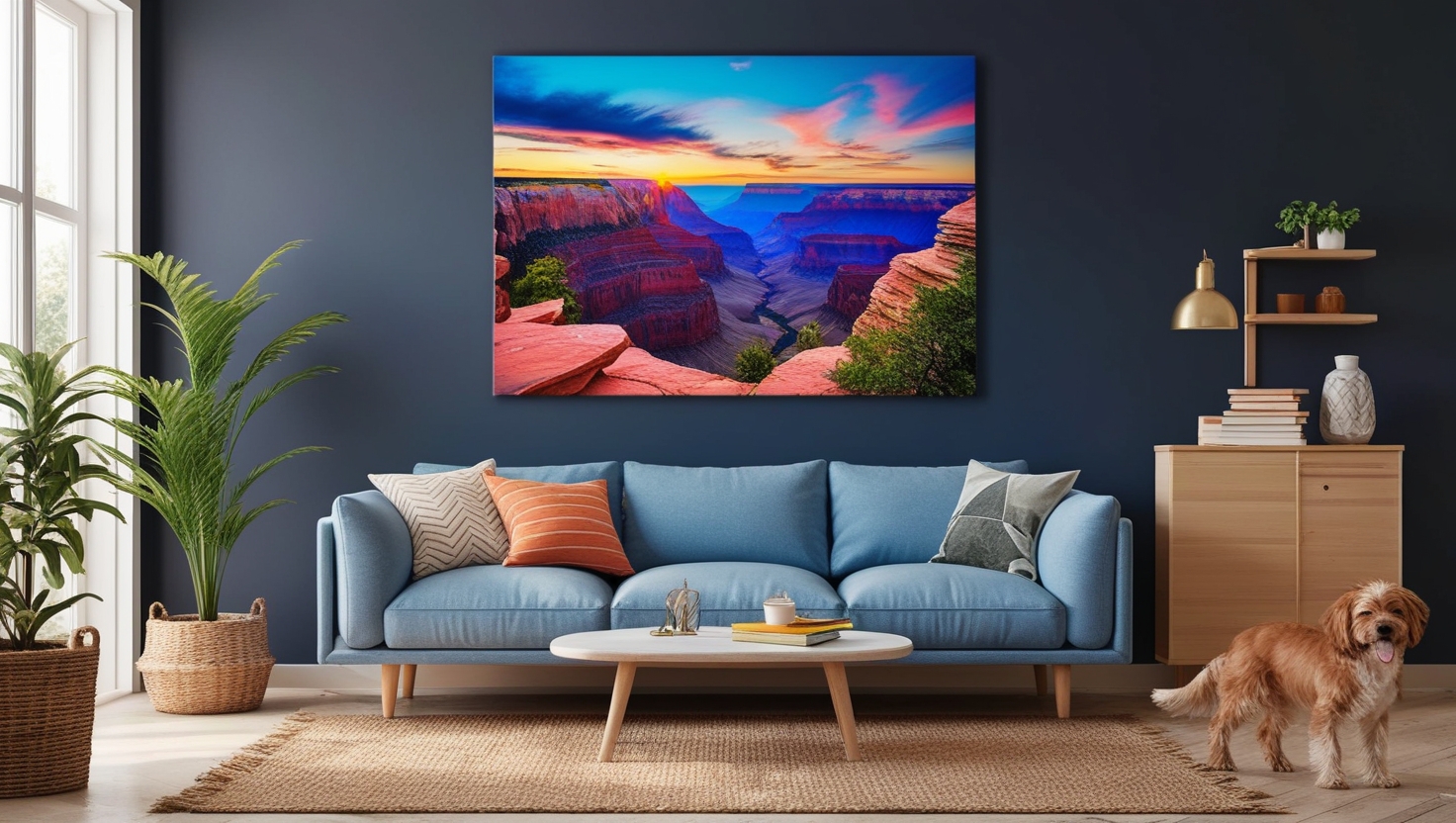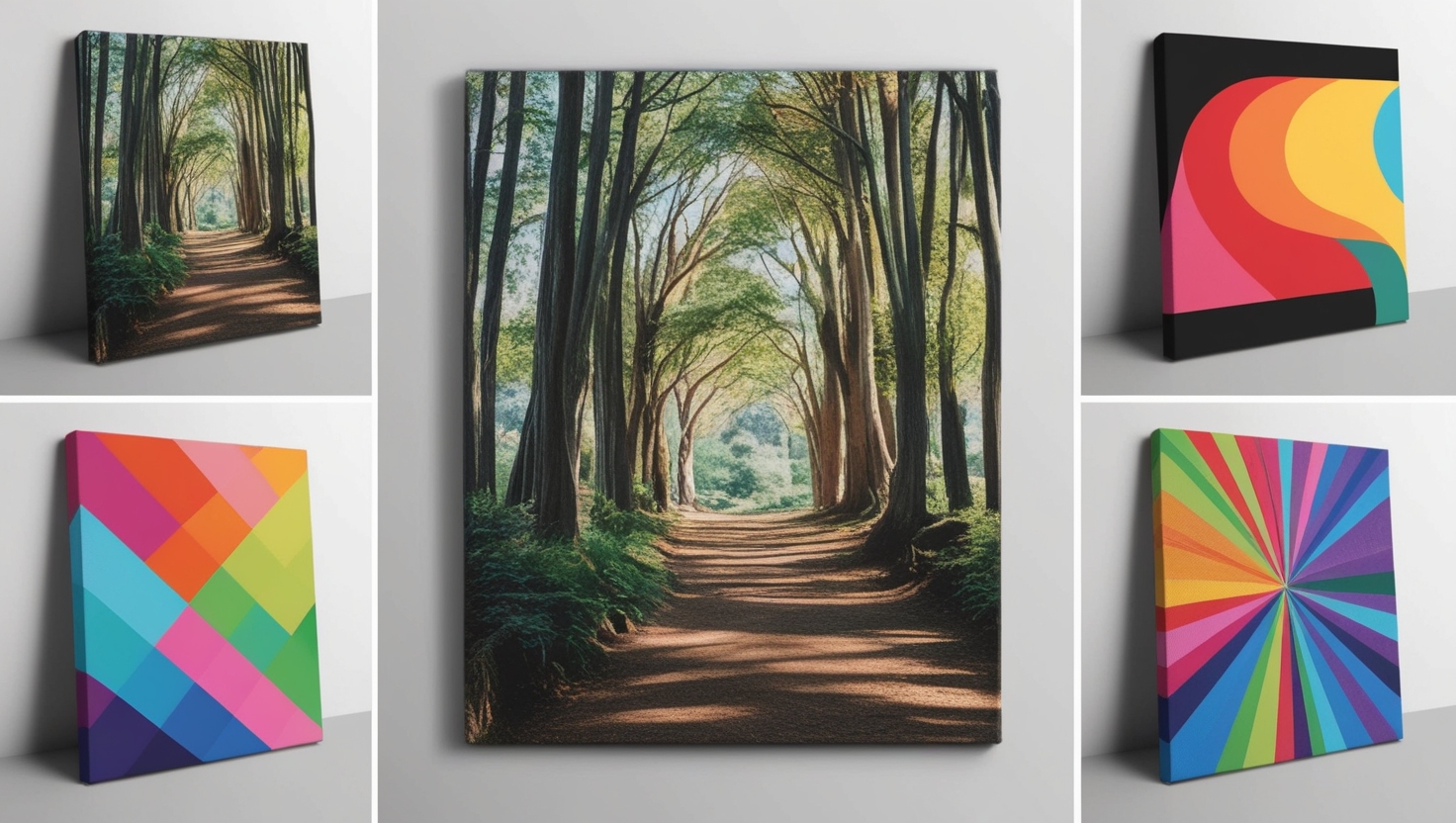Canvas Prints for Walls: Pros and Cons You Need to Know
Posted by MintSuper Art on 18th Dec 2024
A blank wall feels like it’s waiting for a story, doesn’t it? Canvas prints are one of the easiest ways to tell that story—lightweight, affordable, and vibrant enough to make a space feel alive. I remember ordering one for my dorm room, a photo of the beach back home, and it instantly made the sterile walls feel like mine. But they’re not perfect.
Humidity can mess with them, and they’ll never have the texture of real, hand-painted art. Still, for the price and ease, they’re hard to beat. Keep reading to weigh the pros and cons and see if they’re the right fit for your space!
Key Takeaway
- Canvas prints are durable and can last for many years.
- They offer unique customization options for personal style.
- However, they can be more expensive and may not capture fine details as well as paper prints.
Weighing the Benefits and Drawbacks of Canvas Prints
Canvas prints are durable and give a polished, gallery-like look, but they may not always be the best fit for every situation. They offer texture and depth, yet can be heavier to hang and less flexible in very small spaces. Thinking about where you’ll place them can help you decide whether they’re the right choice. To get a clearer sense of how they compare with other options, review our guide on canvas vs. paper wall art prints and see how each material measures up in terms of cost, care, and presentation.
Pros of Canvas Prints

1. Durability
Canvas prints have this almost stubborn ability to last. Like, seriously—up to 75 years if they’re taken care of. That’s longer than most of us will keep a couch. Unlike paper prints, which can wrinkle or tear if you so much as look at them the wrong way, canvas is tough.(1)
It resists scratches, and it’s not going to crumble if it gets bumped. I’ve seen one survive a toddler’s curious fingers and a dog’s wagging tail. Plus, they handle humidity and temperature changes better than paper prints, which is why my aunt’s Grand Canyon sunset still looks as vibrant as it did a decade ago, even though it’s hung right next to a sunny window.
2. Aesthetic Appeal
There’s something about the texture of canvas that makes images feel... I don’t know, more real? It’s like the difference between watching a movie on your phone versus in a theater. The colors on canvas prints often look richer, deeper—like they’ve been painted on instead of printed.
That texture adds depth, making the art pop in a way flat paper just can’t. And because they’re so versatile, canvas prints can fit any vibe, whether you’re into sleek, modern spaces or cozy, vintage ones. I’ve seen them work in everything from minimalist apartments to homes with floral wallpaper and antique furniture.
3. Customization Options
This is where canvas prints really shine. You can make them yours. Want a gallery wrap where the image spills over the edges? Done. Need a specific size to fit that awkwardly narrow wall in your hallway? No problem. You can even choose frames or finishes to match your decor. My cousin once created a whole gallery wall of family photos on canvas, each one a different size, and it looked like something out of a design magazine. The flexibility lets you show off your personality, whether that’s through bold, oversized prints or a carefully curated collection of smaller pieces.(2)
4. Lightweight and Easy to Hang
Here’s the thing: traditional framed artwork can be a pain. They’re heavy, and you always need to worry about finding the right kind of hook or nail. Canvas prints? Way easier. They’re lightweight, so you don’t need industrial-strength hardware to hang them. I once helped a friend redecorate her living room, and we had her canvas prints up in under ten minutes. No frames to mess with, no glass to clean. And if you decide to rearrange your space (which I do way too often), it’s simple to move them around without worrying about damaging your walls—or your back.
5. No Glare
This might not seem like a big deal until you’ve tried to admire a framed photo in a sunny room. The glare from the glass can make it impossible to see the image unless you’re standing at just the right angle. Canvas prints don’t have that issue. Their matte finish means no reflections, no matter how much light is streaming in. My mom has a canvas print of a beach scene in her sunroom, and it looks just as clear at noon as it does in the evening. It’s one of those underrated features that makes a huge difference, especially in bright spaces.
Cons of Canvas Prints

1. Cost: Not Always Wallet-Friendly
Canvas prints aren’t always the most affordable option. A standard 24x36 canvas, for instance, can cost anywhere from $80 to $150, depending on the company and customization. For those on a tight budget, this can feel like a steep price compared to paper prints or posters, which often cost a fraction of that.
The market for canvas prints is growing at about 5.4% annually, which means more options are available, but prices don’t always reflect that growth. Larger sizes or special finishes—like matte or glossy coatings—can push the price even higher. For someone looking to decorate on a budget, these prints might not be the best choice.
2. Limited Detail Capture: Not for the Perfectionists
Canvas prints can struggle to capture fine details. The texture of the material, while adding a unique aesthetic, tends to soften sharp lines and intricate patterns. For images with delicate details—like architectural photography or highly detailed illustrations—this can be a drawback.
Photos with fine textures or subtle gradients may lose some of their clarity when transferred to canvas. Paper prints, by contrast, often provide a crisper, more precise representation of the original image. For anyone prioritizing detail, this is something worth considering.
3. Vulnerability to Damage: Handle With Care
Despite their durability in some respects, canvas prints are still fabric stretched over a frame, making them vulnerable to damage. A small tear or scratch can ruin the entire piece. Moisture, in particular, poses a significant risk. Bathrooms, kitchens, or any space with high humidity can cause the canvas to warp or develop mold.
Even in dry areas, accidents can happen. A bump from furniture or a spill nearby can leave permanent marks. Careful placement and handling are essential to keep canvas prints looking their best.
4. Color Accuracy Issues: Not Always Picture-Perfect
The texture of canvas can alter how colors appear, often making them look softer or less vibrant than expected. For those who want their prints to match the original photo exactly, this can be disappointing. Blues might shift toward teal, reds might lose their punch, and overall brightness can feel muted.(3)
Some printing companies offer sample prints to help manage expectations, but not everyone takes advantage of this option. Without seeing a preview, the final product might not meet expectations, especially for photos with bold or precise color schemes.
5. Heavy Sizes: Bigger Isn’t Always Better
Large canvas prints can be deceptively heavy. A 30x40 canvas, for example, can weigh upwards of 10 pounds, depending on the frame and material. Hanging such a piece requires sturdy hardware and, often, drilling into walls.
For renters or those with limited tools, this can be a hassle. Smaller sizes are easier to manage but may not have the same visual impact. Larger prints, while impressive, come with added responsibilities, like ensuring the wall can support the weight and using proper anchors to avoid accidents.
Practical Tips for Potential Buyers
Credits : The Danish Painter
Canvas prints can be a great addition to a space, but they’re not without their challenges. To make the most of them:
- Set a clear budget before shopping to avoid overspending.
- Choose images carefully, favoring those that don’t rely on intricate details.
- Avoid high-moisture areas to prevent warping or damage.
- Request a sample print if color accuracy is a concern.
- Use appropriate hardware for hanging, especially for larger sizes.
While canvas prints offer a unique way to display photos, their quirks mean they’re not the right fit for every situation. For those willing to navigate the potential downsides, they can still be a striking and personal form of wall art.
FAQ
What's the main difference between canvas and poster prints for wall decor?
Canvas prints provide a textured, matte finish that mimics traditional paintings, while paper prints and poster prints offer a smoother surface. The difference between canvas and poster options mainly comes down to material and presentation. Canvas material has a woven texture that can add depth to images, especially for art prints and photos, while paper prints typically deliver sharper detail.
How do canvas prints compare to other materials like acrylic photo prints and metal prints?
Canvas prints offer a classic, artistic look, while acrylic photo prints provide a modern, glossy appearance. Metal prints deliver a contemporary feel with high color vibrancy. Each material affects the final look differently - canvas has a more traditional aesthetic appeal, while acrylic and metal create a sleek, contemporary vibe.
What advantages of canvas prints should I consider for my walls?
Canvas prints provide several benefits: they're scratch resistant, glare and reflections are minimal due to the matte finish, and they're often budget friendly. They're great for larger sizes and offer versatile customization options, including split canvas arrangements for dramatic effect. The texture of canvas material can add artistic effects to any photo canvas or fine art reproduction.
Are there disadvantages of canvas prints I should know about?
Some prints look better on paper, especially when it comes to crisp details in black and white photography. The disadvantages of framed canvas prints include their weight and depth from the wall. Personal preference plays a big role - some people find that certain art prints look better on traditional photo paper or foam board, particularly for highly detailed images.
How should I approach choosing between canvas and other print options?
Consider your interior design goals, image size requirements, and whether you prefer paper or canvas textures. Quality canvas prints can last a long time, but so can well-made paper prints. The better option depends on your specific needs - canvas prints and posters each have their place. For oil painting reproductions, canvas often works better, while detailed photos might shine on photo paper.
Conclusion
When deciding between canvas prints and other art options, it helps to know the pros and cons. Canvas prints are durable and beautiful, great for personalizing home decor. But, they can be pricier and may not show fine details as well. Weighing these points can help find the best wall art for any space.
References
- https://www.thecanvasprints.co.uk/canvas-printing-...
- https://printposters.in/Blog/Advantage-and-Disadva...
- https://www.canvasprintsperth.com.au/the-pros-cons...

